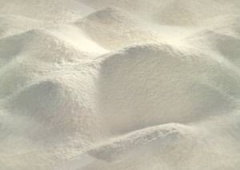Carrageenan (Red Seaweed)
| Infobox on Carrageenan (Red Seaweed) | |
|---|---|
| Example of Carrageenan (Red Seaweed) |  |
| Facts | |
| Origin | - |
| Stowage factor (in m3/t) | - |
| Humidity / moisture | - |
| Ventilation | - |
| Risk factors | See text |
Carrageenan (Red Seaweed)
Contents
Description
Carrageenans or carrageenins are a family of linear sulfated polysaccharides that are extracted from red seaweeds. There are several varieties of carrageen used in cooking and baking. Kappa-carrageenan is used mostly in breading and batter due to its gelling nature. Lambda carrageenan is a non-gelling variety that assists in binding, retaining moisture, and in contributing to viscosity in sweet doughs. Iota carrageenan is used primarily in fruit applications and requires calcium ions to develop a heat-reversible and flexible gel. Gelatinous extracts of the Chondrus crispus (Irish Moss) seaweed have been used as food additives for hundreds of years. Carrageenan is a vegetarian and vegan alternative to gelatin.
There are three main commercial classes of carrageenan:
- Kappa forms strong, rigid gels in the presence of potassium ions; it reacts with dairy proteins. It is sourced mainly from Kappaphycus alvarezii.
- Iota forms soft gels in the presence of calcium ions. It is produced mainly from Eucheuma denticulatum.
- Lambda does not gel, and is used to thicken dairy products. The most common source is Gigartina from South America.
The primary differences that influence the properties of kappa, iota, and lambda carrageenan are the number and position of the ester sulfate groups on the repeating galactose units. Higher levels of ester sulfate lower the solubility temperature of the carrageenan and produce lower strength gels, or contribute to gel inhibition (lambda carrageenan).
Many red algal species produce different types of carrageenans during their developmental history. For instance, the genus Gigartina produces mainly kappa carrageenans during its gametophytic stage, and lambda carrageenans during its sporophytic stage. See Alternation of generations.
All are soluble in hot water, but in cold water, only the lambda form (and the sodium salts of the other two) are soluble.
Application
Carrageenan is a product derived from certain types of red algae, a seaweed found throughout the coasts of North America and Europe. The product is most often used as a thickening agent in place of animal-based products like gelatin, which is extracted from animal bones. It is a common ingredient in many foods and gel-like products, and even has applications in biochemistry. Carrageenan is nearly identical to agar, another substance derived from several different species of red algae.
In food and other products, carrageenan works as a thickener, stabilizer, and emulsifier, meaning that it helps keep mixed ingredients from separating. It gives foods a smooth texture and accentuates flavor. It is often used in dairy-based foods, like ice cream, yogurt, and cottage cheese, because it reacts well with milk proteins. Carrageenan is also found in jelly, pie filling, chocolate, salad dressing, and even as a fat substitute in processed meat. Because it comes from algae, it can be used as a substitute for gelatin for vegetarian and vegan products.
Other, non-food items, like toothpaste, personal lubricants, and air freshener gels may also include carrageenan. It serves the same function as it does in foods — to thicken and stabilize the product, and make it smoother. Some types of fire fighting foam also use carrageenan, which thickens the foam and helps it become sticky and more effective. In chemistry, gels made with it can be used to carry microbes or immobilize cells.
Shipment / Storage
This product, which is manufactured as a powder, is increasingly used as an alternative to gelatine and has substantial worldwide sales. It is normally bagged and shipped in containers.
Although neither carrageenan nor seaweed are classified as dangerous cargoes in the IMDG Code, the product has been involved in an incident off late, which indicates that the
carriage of carrageenan may be a potential fire hazard in certain circumstances.
In this case, a cargo simply described by the shipper as 640 bags of "Carrageenan", was shipped by container from China to Europe. The container was packed by the shipper. The cargo was not
declared as dangerous goods and was stowed below deck immediately adjacent to a heated fuel tank.
Upon discharge at the European port the outside of the container showed clear evidence of internal heating and blistering. When the container was opened the cargo of carrageenan was found to be
blackened and had formed into a type of charcoal. The cargo was subsequently determined to be a total loss.
Expert chemists carried out an extensive investigation and testing of both the damaged cargo and samples of fresh carrageenan powder from various sources.
Their tests established that a range of carrageenan products start to decompose exothermically (i.e. decomposition giving off heat) at temperatures of about 125° - 180°C. The decomposition of some samples gave off so much heat that they reached temperatures of between 600° - 740°C; high enough to ignite ordinary combustible materials. On the basis of the experts' investigation, it is suspected that a combination of heat from the adjacent fuel tank and high ambient temperatures started the exothermic decomposition of a combination of the product.
The lowest temperature at which exothermic decomposition was observed to start in the experts' tests was 125°C. However, outside laboratory conditions the experts believe that decomposition of carrageenan stored in a container could well start at lower temperatures. The Association's experience of the cargo catching fire clearly implies that exothermic decomposition can begin at much lower temperatures, as 125°C is rarely to be found in ship's holds.
Accordingly, ensure that carrageenan products are always stowed away from sources of heat.
Risk factors
Consult the applicable MSDS sheet.











